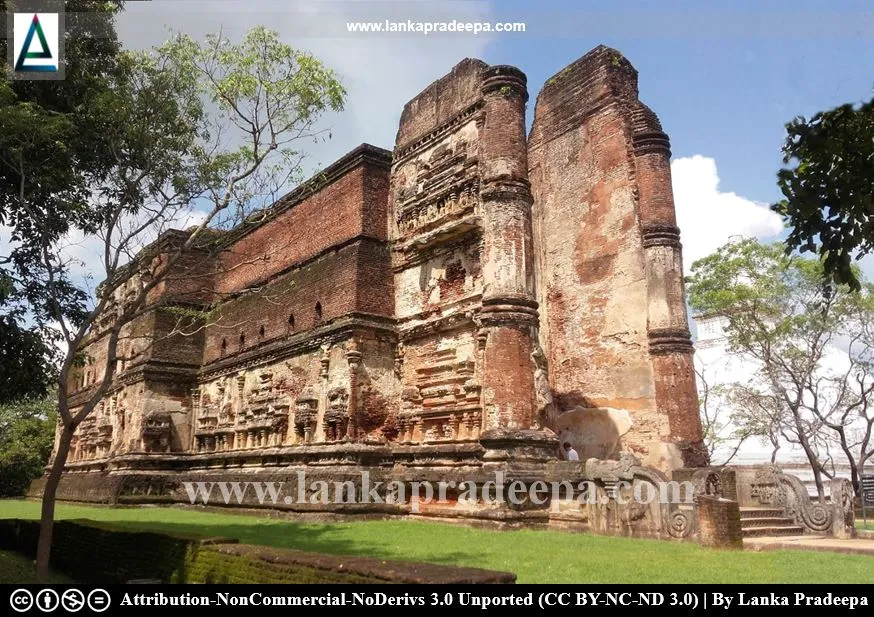
The Lankatilaka Pilimage/ Pilima Geya or Lankatilaka image house (Sinhala: ලංකාතිලක පිළිම ගෙය) is a Gedige (vaulted) type image house located in the Ancient City of Polonnaruwa, Sri Lanka. It is considered the largest image house constructed in ancient Sri Lanka.
History

Constructed by King Parakramabahu I (1153-1186 A.D.), the Lankatilaka image house belonged to the Alahana Pirivena monastery (Wikramagamage, 2004). Epigraphical evidence is there to prove that this image house had been renovated during the reign of King Vijayabahu IV (1270-1272 A.D.) of the Dambadeniya Period (Ranawella, 2014; Wickremasinghe, 1933).
Image House
The image house which is said to consist of five stories has been completely built out of bricks including the roof and therefore, known as a Gedige-type image house. There are three examples of this type of vaulted-roof shrine at Polonnaruwa; viz: Thuparama Pilimage, Lankathilaka Pilimage, and Thivanka Pilimage.

The ground plan of the Lankathilake image house mainly consists of three parts: the sanctum, the vestibule, and the entrance porch. The entrance porch faces the east. A flight of steps associated with two Korawak Gal (wingstones) and two Muragal (guard stones) can be seen at the beginning of the entrance. The balustrades and guard stones have been decorated with ornate carvings and some believe that the low-relief figure carved in the guard stones represents Dratarastra Maharaja, the lord of the east (Wikramagamage, 2004). Also, the woman figure presenting on the inner side of the balustrade (see the photograph under the "Inscription" section), according to some, is the wife of Dratarastra (Wikramagamage, 2004). This woman figure who is in a trice-bent pose carries a pot in her left hand while holding a bunch of flowers in her right hand (Wikramagamage, 2004). She is accompanied by two attendant women.
In the sanctum is a giant headless standing Buddha statue with broken hands. The Buddha statue is more than 40 feet high and has been built
attached to a screen wall between which and the inner side of the rear
wall of the image house is a narrow ambulatory (Ray, 1960). The edge of the robe falling down from the left hand had been supported by a lion figure (now destroyed) seated on the lotus pedestal. The giant Buddha statue and the two pylons at the entrance of the image house (which are about 55 feet high in
its destroyed state) have given a majestic appearance to the image
house.

Two ground levels are observed inside the sanctum. A portion with the same level of the vestibule is in front of the pedestal of the image and on either side of this portion, the ground has been elevated. These raised grounds have been planted with square-shaped stone pillars with decorated capitals. The pillars as well as the beam holes on the sidewall indicate the existence of an old upper story or gallery of wooden construction for the veneration of the image (Ray, 1960). The flight of steps attached to the side walls had led the devotees to the roof for the purpose of circumambulation. Originally, the
Buddha statue had been sheltered with a brick-made vaulted roof but presently remains in the open environment as the vault collapsed
long ago.
The exterior walls of the image house have been adorned with stucco relief sculptures depicting miniature edifices (Vimana/ Pasadas) together with divinities (Ray, 1960). The remaining painting fragments on the walls indicate that the image house had been adorned with wall paintings. In front of the Lankatilaka image house is a building with carved stone pillars (a pillared Mandapa) which is believed to be a pavilion for Hevisi drummers.
Inscription

An inscription of King Vijayabahu IV (1270-1272 A.D.) is found inscribed on the inner side of Muragala (guard stone) located at the left side of the entrance porch (Ranawella, 2014; Wickremasinghe, 1933). It contains 17 lines of Pali writing shallowly engraved on the rock surface (Wickremasinghe, 1933).
The record is framed in two Gathas, each containing two-nineteen syllable lines (Ranawella, 2014). The first Gatha records the erection of the Lankathilaka temple by King Parakramabahu I and the second Gatha states that the temple had remained in disrepair for 100 years when King Vijayabahu IV had it completely rebuilt (Ranawella, 2014). Two conventional signs of a conch-shell mark the end of the text (Ranawella, 2014).
Lankatilaka Guard Stone Inscription
Reign: Vijayabahu IV (1270-1272 A.D.) Period: 13th century A.D.
Language: Pali Script: Medieval Sinhala
Reign: Vijayabahu IV (1270-1272 A.D.) Period: 13th century A.D.
Language: Pali Script: Medieval Sinhala
Content: The inscription says that King
Vijayabahu IV renovated the Lankatilaka
Viharaya, hundred years after it was built
by the great King Parakramabahu.
Reference: The information board at the
site by the Department of Archaeology
and the Ministry of National Heritage.
Stucco decorative sculptures
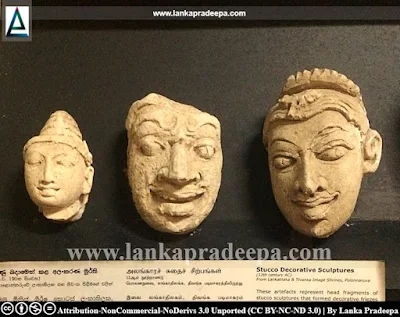
Several head fragments of stucco sculptures recovered from Lankatilaka and Thivanka image houses in Polonnaruwa have been presently preserved in the National Museum of Colombo. These clay-made figures that formed decorative friezes of the plinths of the aforesaid two image houses have a humorous and dwarfish countenance. The hairstyles, broad lips, teeth, and large open eyes have also intensified the amusing appearance of these figures.
These decorative sculptures belong to the 12th century A.D. and are examples of the primitive clay figurines of the ancient folk art tradition.
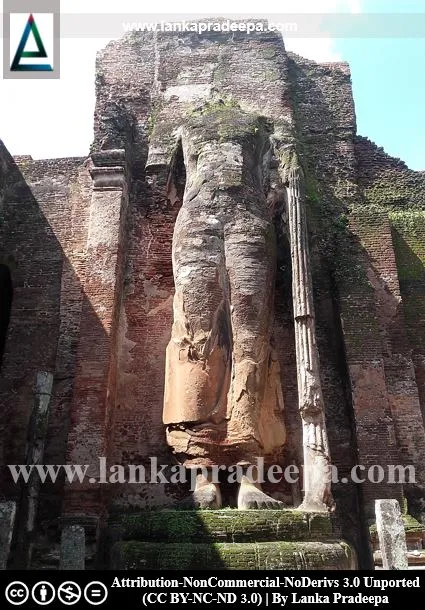

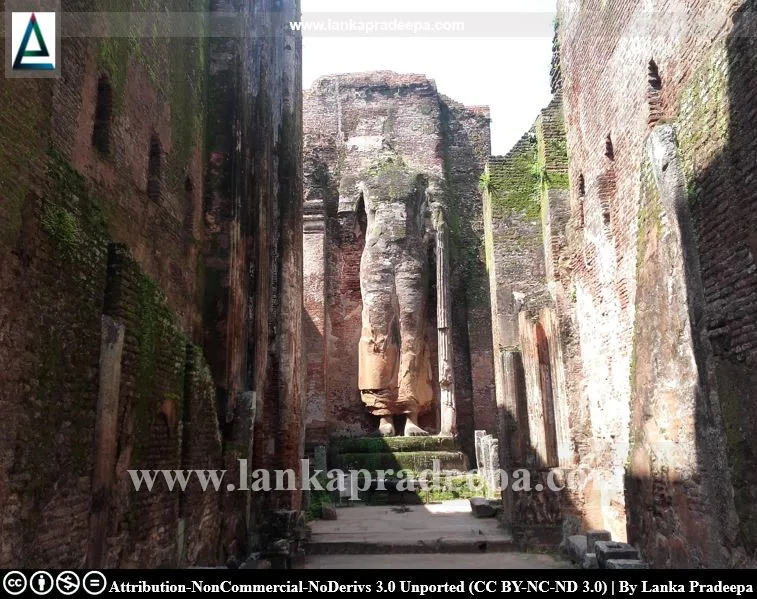

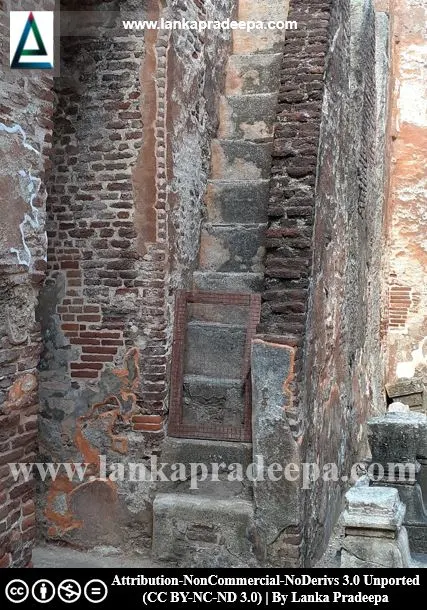
.
Attribution
1) Lankatilaka temple 02 by Bgag is licensed under CC BY SA 3.0
References
1) Ranawella, S., 2014. Archaeological Survey of Ceylon: Inscriptions of
Ceylon: Vol. VII. Department of Archaeology. ISBN: 978-955-9159-62-9.
pp.13-15.
2) Ray, H. C. (Editor in Chief), 1960. University of Ceylon: History of Ceylon (Vol 1, part II). Ceylon University Press. pp.597-598.
3) Wikramagamage, C., 2004. Heritage of Rajarata: Major natural, cultural and historic sites. Colombo. Central Bank of Sri Lanka. p.217-218.
4) Wickremasinghe, D.M.D.Z., 1933. (Edited and translated by Wickremasinghe, D.M.D.Z.; Codrington, H.W.) Polonnaruwa: Lankatilaka guard stone inscription of Vijaya-Bahu IV. Epigraphia Zeylanica: Being lithic and other inscriptions of Ceylon: Vol. III. Printed at the Department of Government Printing, Sri Lanka (Ceylon) for the Archeological Department. pp.48-50.
2) Ray, H. C. (Editor in Chief), 1960. University of Ceylon: History of Ceylon (Vol 1, part II). Ceylon University Press. pp.597-598.
3) Wikramagamage, C., 2004. Heritage of Rajarata: Major natural, cultural and historic sites. Colombo. Central Bank of Sri Lanka. p.217-218.
4) Wickremasinghe, D.M.D.Z., 1933. (Edited and translated by Wickremasinghe, D.M.D.Z.; Codrington, H.W.) Polonnaruwa: Lankatilaka guard stone inscription of Vijaya-Bahu IV. Epigraphia Zeylanica: Being lithic and other inscriptions of Ceylon: Vol. III. Printed at the Department of Government Printing, Sri Lanka (Ceylon) for the Archeological Department. pp.48-50.
Location Map
This page was last updated on 14 November 2022

